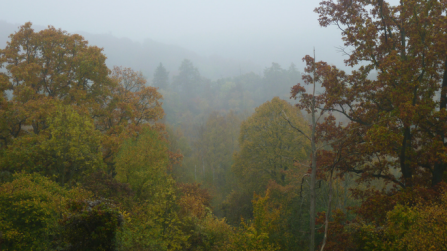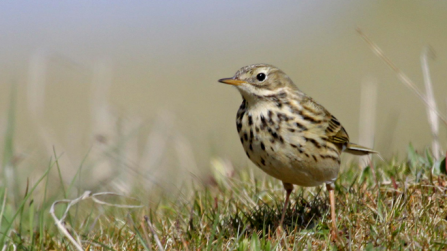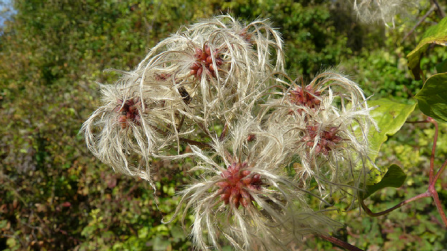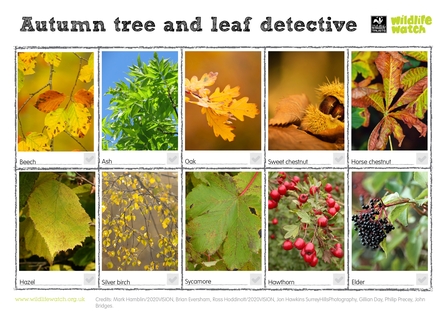
Our top 10 wildlife sightings in October
(C) Margaret Holland

Autumn colours
As the month progresses, woodlands start to turn all shades of gold, orange and bronze, and the ground becomes covered with a thick layer of fallen leaves. Delve more into the science behind how and why leaves change colour in our blog.
Use our handy id chart below to identify which tree the fallen leaves have come from.
Woodland reserves including Bowdown Woods, Dancersend and Warburg Nature Reserve are renowned for their beautiful autumn colours. Share your photos of the colours of autumn with us on Twitter, Facebook and Instagram.

Berries and nuts
This year hedgerows, shrubs and trees are bursting with berries, fruits and nuts, which birds and small mammals are feasting on. From the plant’s point of view, berries are simply attractive packaging, designed to tempt other creatures to tuck in and distribute their seeds to other places. If you're tempted to forage for a few berries, don't forget to leave plenty for the wildlife.
Look out for jays and squirrels burying nuts to eat when it gets colder and food is scarce. Did you know the scientific name for jays translates as 'chattering acorn gatherer'!

Peter Creed
Fungi
Look for fungi growing in all sorts of different places from dead trees and fallen branches to the woodland floor and even grassland. Remember, some fungi can be deadly if eaten so it’s best to leave them for others to admire too.
Learn more about the secret world of fungi.

(C) Margaret Holland
Blackbirds
During the autumn the number of blackbirds in Britain increases dramatically as birds from northern Europe come here for the winter, where conditions are milder. Later in the autumn they'll be joined by other thrushes including redwing and fieldfare.
Blackbirds, and other thrushes, like feeding on windfall apples in gardens, so don’t tidy them all way!

Goldfinches and linnets
Look out for mixed flocks of goldfinches (left) and linnets (right) feeding on seed heads of plants, such as thistles and teasel, particularly around farmland like Wells Farm nature reserve. This working farm is managed with wildlife in mind with wide field margins and thick hedgerows to provide food and shelter for wildlife through the year.

Meadow pipits
During the autumn and winter meadow pipits move further south in Britain. Here conditions are milder than the uplands they live in during summer. Look out for small flocks of them on farmland and areas of grassland at places like Chimney Meadows nature reserve.

Merlins
Merlins are the UK’s smallest bird of prey, not much bigger than a blackbird. During the winter months they move south from upland areas towards the coast and lowland areas inland. Look for them hunting small birds in open countryside.

Robins
Familiar to all of us, you might notice more robins around during the autumn and winter. Juvenile robins are starting to get their red breasts so they become more recognisable as robins, and other robins are arriving here from northern Europe. Some of these will stay and spend the winter in Britain while others are passing through on their way to southern Europe or North Africa.
Listen out for robins singing at dusk through autumn and winter as they defend their territories.
Did you know robins have been associated with Christmas ever since Victorian times; Victorian postmen, who were known as 'Robin Red-breasts' because of their red waistcoats, are thought to be the inspiration for so many robins appearing on our Christmas cards.

Spiders
Autumn is a good time to look for spiders in gardens, along hedgerows, in heathland, and even in your house! Look out for the huge variety of spiders and their webs, particularly on cooler mornings when their webs glisten with dew.
Find out more about the spiders you might find in your house, and why spiders are something to celebrate and not fear in our blog.

Wild clematis or old man's beard. Photo by GanMed64/flickr.com
Wild clematis
Wild clematis becomes more noticeable in the autumn thanks to the fluffy seed heads; hedgerows can be covered with this climber as it scrambles over shrubs.
Finches feed on the seed heads and many different species will use the fluffy seed heads for nesting material in the spring. The distinctive silky hairs on the seed heads give it its common name of 'old man’s beard'.
Woodland wildlife in autumn spotter sheet
Download our autumn wildlife spotter sheet for some other wildlife to look out for this month. Will you spot them all?

Stay up-to-date with our work
Sign up below to receive the latest news from BBOWT, tips about how you can help wildlife, plus information on how you can get involved.


